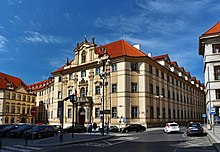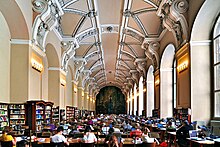National Library of the Czech Republic
| National Library of the Czech Republic | |
|---|---|
 Baroque library hall in the National Library of the Czech Republic | |
 | |
| 50°5′14.62″N14°25′2.58″E/ 50.0873944°N 14.4173833°E | |
| Location | Clementinum,Prague,Czech Republic |
| Type | National library |
| Established | 1777 |
| Collection | |
| Size | 7,358,308 total items[1] 21,271 manuscripts[1] c. 4,200 incunabula[2] |
| Other information | |
| Director | Tomáš Foltýn |
| Website | www |
TheNational Library of the Czech Republic(Czech:Národní knihovna České republiky) is the central library of theCzech Republic.It is directed by theMinistry of Culture.The library's main building is located in the historicalClementinumbuilding in the centre ofPrague,where approximately half of its books are kept. The other half of the collection is stored in the district ofHostivař.[3]The National Library is the biggest library in the Czech Republic, housing around 6 million documents. The library currently has around 20,000 registered readers.[1]Although comprising mostly Czech texts, the library also stores older material from Turkey, Iran and India.[4]The library also houses books forCharles University in Prague.[5]
History[edit]
In the 13th century, theStudium generaleschool was founded in theDominicanmonasteryin Prague'sOld Town.This school, including its library, merged with the university in the 14th century.
In 1556,monksof theJesuit Ordererected aboarding school,namedClementinum,on the remains of the Dominican monastery. From 1622 on, the Jesuits also administered theCharles University,and all their libraries were accommodated in the Clementinum.

After thesuppression of the Jesuits,the university became a state institution in 1773, and in 1777 its library was declared "Imperial-Royal Public and University Library" byMaria Theresa.Even after the splitting of the university into a Czech and a German university in 1882, the library remained as a joint institution.
In 1918, the Public and University Library was taken over by the government of the newly foundedCzechoslovakia.In 1924, theSlavonic Library(Slovanská knihovna) was founded, and moved to the Clementinum in 1929; it is still an autonomous part of the National Library. In 1935, the library was renamed "National and University Library" (Národní a univerzitní knihovna). In the same year, a law on thelegal depositcopy duty was introduced – a practice dating back to 1781, when Pragueprintershad to hand in legal deposit copies of their prints to the library.
Although Czech universities and colleges were closed after theGerman occupation of Czechoslovakiain 1939, the library remained open under the name of "Municipal and University Library" (Zemská a univerzitní knihovna).
In 1958, all large Prague libraries were merged into the single centralized State Library of the Czechoslovak Republic (Státní knihovna CSR).
In 1990, the hitherto last renaming of the library resulted in its current name: National Library of the Czech Republic. A new storage building, the Central Depository inHostivař,was inaugurated in 1996.[6]
Collections[edit]
The most precious medieval manuscripts preserved in the National Library are theCodex Vyssegradensisand thePassional of Abbes Kunigunde.
Digitisation[edit]
The National Library of the Czech Republic began with theirdigitisationefforts in 1992 in collaboration with the Czech company AiP Beroun. In these efforts, the National Library conducted pioneer work on a global scale in the creation of digitization standards. Later, it got involved in a number of European projects, in which it came to additional developments particularly standards regarding manuscripts and old prints. It also supported several pilot projects at the time of their creation and the first years of theUNESCOMemory of the World Programme(with the programme's first pilot project being from the National Library of the Czech Republic in 1993).
The library won international recognition in 2005 as it received the inauguralJikji PrizefromUNESCO'sMemory of the World Programmefor its efforts in digitising old texts.[7][8]In its first 13 years since 1992, the project accomplished the digitisation of 1,700 documents and made them publicly available.[4]
The National Library makes its digital content available in the digital librariesManuscriptorium(http:// manuscriptorium /en) andKramerius(http://kramerius5.nkp.cz). Manuscriptorium comprises more than 111,000 manuscripts and old prints, with almost 84,000 of them contributed by the National Library and the remainder from 138 partners from 24 countries.[citation needed]Since 2008, whenEuropeana,theEuropean Union's digital platform forcultural heritage,came into existence, Manuscriptorium contributes manuscripts and old prints digitised by libraries all over the Czech Republic and by other partners to the Europeana platform and several other specialised portals, including professional academic Resource Discovery services, e.g. of EBSCO, ProQuest and ExLibris.
In a collaborative project withGoogle,additional old prints and early 19th century books from theSlavonic Libraryhave been digitised, with altogether more than 177,000 books digitised by Google (as of October 2018).[citation needed]These books are accessible through theGoogle Booksdigital library as well as through the National Library's Catalogue of Old Prints and the Catalogue of the Slavonic Library, and the old prints gradually also through Manuscriptorium.
The Kramerius digital library contains digitised documents published after the year 1800. So far, more than 2,000 periodical series have been digitised. The number of digitized books continues to grow, especially after mass digitization of modern prints in context of the National Digital Library project.[citation needed]
Proposed new building[edit]

In 2006, the Czech parliament approved funding for the construction of a new library building onLetnaplain, betweenHradčanskámetro station andSparta Prague's football ground,Letná stadium.[9][10]In March 2007, following arequest for tender,Czech architectJan Kaplickýwas selected by a jury to undertake the project, with a projected completion date of 2011.[11]Later in 2007 the project was delayed following objections regarding its proposed location from government officials including Prague MayorPavel Bémand PresidentVáclav Klaus.[10][12]Plans for the building had still not been decided in February 2008, with the matter being referred to the Office for the Protection of Competition in order to determine if the tender had been won fairly.[13]Later in 2008, Minister of CultureVáclav Jehličkaannounced the end of the project, following a ruling from theEuropean Commissionthat the tender process had not been carried out legally.[14]
Incidents[edit]
The library was affected by the2002 European floods,with some documents moved to upper levels to avoid the excess water.[15]Over 4,000 books were removed from the library in July 2011 following flooding in parts of the main building.[16]There was a fire at the library in December 2012, but nobody was injured in the event.[17]
See also[edit]
References[edit]
- ^abcVýroční zpráva Národní knihovny České republiky 2018(PDF)(in Czech). 2019.ISBN978-80-7050-711-7.ISSN1804-8625.Retrieved30 October2019.
{{cite book}}:|journal=ignored (help) - ^"Incunabula".nlp.cz.National Library of the Czech Republic.Retrieved29 June2014.
- ^"Need for new library intensifies".The Prague Post.28 May 2008. Archived fromthe originalon 9 May 2014.Retrieved8 May2014.
- ^ab"National Library's rare prints and manuscripts at the click of a mouse".Radio Prague.2005-11-24.Retrieved2019-12-18.
- ^Tucker, Aviezer (18–24 February 2009)."Opinion"(PDF).The Prague Post.Prague. p. A4. Archived fromthe original(PDF)on 9 May 2014.Retrieved8 May2014.
- ^"From Klementinum's History".National Library of the Czech Republic, Prague. 2012.Retrieved2019-09-16.
- ^"National Library wins UNESCO award for pioneering digitisation work".Radio Prague.2005-09-07.Retrieved2019-12-18.
- ^"2005 - The National Library of the Czech Republic".UNESCO.Retrieved2019-12-18.
- ^"National Library to get major new building while Clementinum will undergo extensive renovations".Radio Prague.30 March 2006.Retrieved8 May2014.
- ^ab"Plans to build modern" blob "building on Letna Plain meet resistance from Prague politicians".Radio Prague.12 October 2007.Retrieved8 May2014.
- ^"Changes ahead for the Czech National Library".Radio Prague.11 March 2007.Retrieved8 May2014.
- ^"'Octopus' library stirs up Czechs ".BBC News.14 May 2007.Retrieved8 May2014.
- ^"Still no final decision on National Library building".Radio Prague.27 February 2008.Retrieved8 May2014.
- ^"Head of National Library sacked over 'Blob' dispute".Radio Prague.10 September 2008.Retrieved8 May2014.
- ^"Art saved from European floods".BBC News.15 August 2002.Retrieved8 May2014.
- ^"Water accident in National Library".Radio Prague.21 July 2011.Retrieved8 May2014.
- ^"No injuries in Czech National Library fire".Radio Prague.4 December 2012.Retrieved8 May2014.
